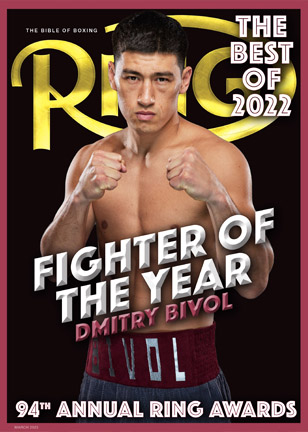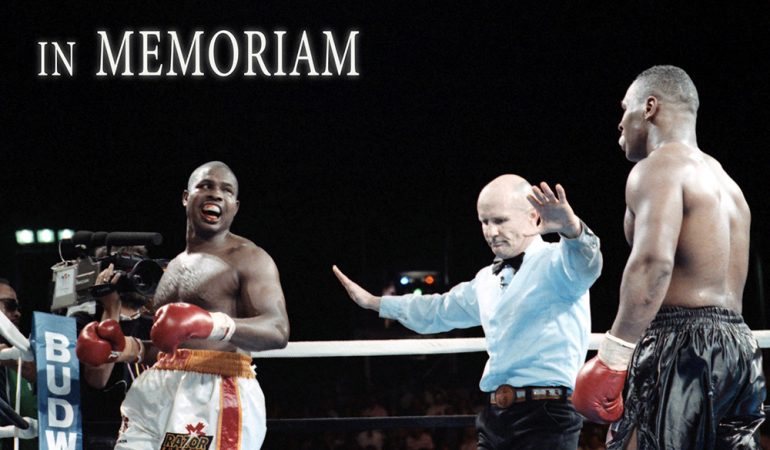
BOXING LUMINARIES WE LOST IN 2022
Above: Referee Mills Lane steps between Donovan “Razor” Ruddock and Mike Tyson at the end of their rematch on June 28, 1991. (Photo: The Ring Magazine via Getty Images)
Marvin Gaye’s hit record Let’s Get It On was released in 1973, which predates Mills Lane’s identical catchphrase as a referee advising two fighters of what he, thousands of on-site spectators and maybe millions of television viewers expected once the opening bell sounded. To be blunt, Mills Bee Lane III, arguably the best and best-known third man in the ring in boxing history, appropriated those four little words for his own use from the Motown soul singer, although the way he said them always came with an exclamation point for emphasis, in keeping with the feisty ref’s Type A personality.
Those four words surely mark the only time Lane, a former Marine, former professional boxer, former deputy sheriff, former district attorney, former municipal court judge and, lastly, former star of his own syndicated courtroom television series, Judge Mills Lane, imitated anything or anyone. A 2013 inductee into the International Boxing Hall of Fame in the Non-Participant category, Lane, who was 85 when he passed away on December 6, was a true original and continuing seminal figure in the fight game despite the stroke that had silenced his voice and sapped him of much of his physical vitality 20 years earlier.
via Walker on YouTube:
By chance or predestination, Mills Lane was instantly distinguishable not only for his bald head and raspy voice, but for the raft of stranger-than-fiction bouts that always seemed to take place on his watch, most notably the “Bite Fight” rematch in which Mike Tyson twice chomped on Evander Holyfield’s ears before Lane was obliged to disqualify the toothy offender on June 28, 1997. Lane also caught the assignments for the Holyfield-Riddick Bowe II “Fan Man” fight in 1993 – when a paragliding intruder attempted to land in the ring of an outdoor bout, prompting a near-half-hour postponement of the action – and Oliver McCall’s perplexing in-fight crying jag against Lennox Lewis in 1997.
“The visibility of the Bite Fight made Mills even more mainstream,” recalled Marc Ratner, former executive director of the Nevada State Athletic Commission. “It always seemed like he worked all the Super Bowls of crazy fights.”
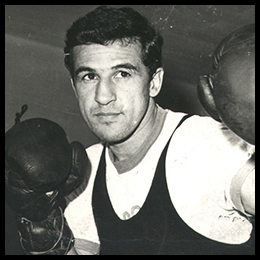
Eder Jofre
As another year in boxing comes to an end, it is time for the traditional 10-count to sound for every person, famous or not, highly accomplished or not, who devoted any part of his or her life to a sport that often requires more from its devotees than any other. Space limitations for this story preclude mentioning by name or affiliation all of the 200-plus fight people who have passed on in 2022, but readers of this story should close their eyes and imagine 10 rings of the bell. It is as it always has been and always shall be, the end of each boxing person’s life cycle in some way signaling the beginning for someone else drawn to follow a similar path.
For purposes of this tribute to the gone but not forgotten, four other Hall of Famers – Brazil’s Eder Jofre and New York City-based Puerto Rican Carlos Ortiz, referee Steve “Double S” Smoger and judge Jerry Roth – share top billing with Lane. The undercard, as it were, features several other fighters who did earn the privilege of being called a world champion, if not quite reaching the pinnacle of IBHOF membership, as well as a raft of those who fought for world titles or achieved a significant degree of advancement toward that end. Some, like Lane, Smoger and Roth, deserve mention for making their marks in related fields.
It is one thing for a fighter to be considered a great practitioner of the pugilistic arts. It is quite another for someone to be considered the very best ever to represent an entire nation, especially one as wide-reaching (3.3 million square miles, the fifth-largest on Earth by land area) and as populous as Brazil (217 million, currently seventh-most). But Eder Jofre, born in Sao Paulo in 1936 amidst widespread civic unrest, was, as one biographer declared upon his death, from complications of pneumonia at 86 on October 2, “a fistic immortal who rose from Brazil’s political ruins.”
Posting a career record of 72-2-4 with 50 victories by knockout, Jofre was certainly among the best fighters of his time – upon observing him at work, the legendary Barney Ross was moved to proclaim, “He is a marvel of boxing perfection; there is nothing he cannot do” – and of all time. In 2002, The Ring named him the 19th-greatest fighter of the past 80 years, and earlier this year, in a special commemorative issue of the “Bible of Boxing” listing the 100 greatest punchers of its century in existence, Jofre came in at No. 85.
Jofre won the vacant National Boxing Association (soon to be the WBA) bantamweight title on a sixth-round knockout of Eloy Sanchez in Los Angeles on November 18, 1960, eventually yielding his world 118-pound belt to Japan’s Fighting Harada by split decision on May 18, 1965. Upon losing the rematch with Harada one year later, this time on a unanimous decision, Jofre retired for three years. But the time off did little or nothing to diminish his ring skills; he seized the WBC featherweight championship from Cuba’s Jose Legra on a 15-round majority decision on May 5, 1973, part of a 25-fight, post-Harada winning streak that finally ended when he stepped away for a second and final time following a 12-round UD over Octavio Gomez on October 8, 1976.
Not once was Jofre defeated inside the distance, and to date he remains the only Brazilian inducted into the IBHOF, in which he was enshrined in 1992.
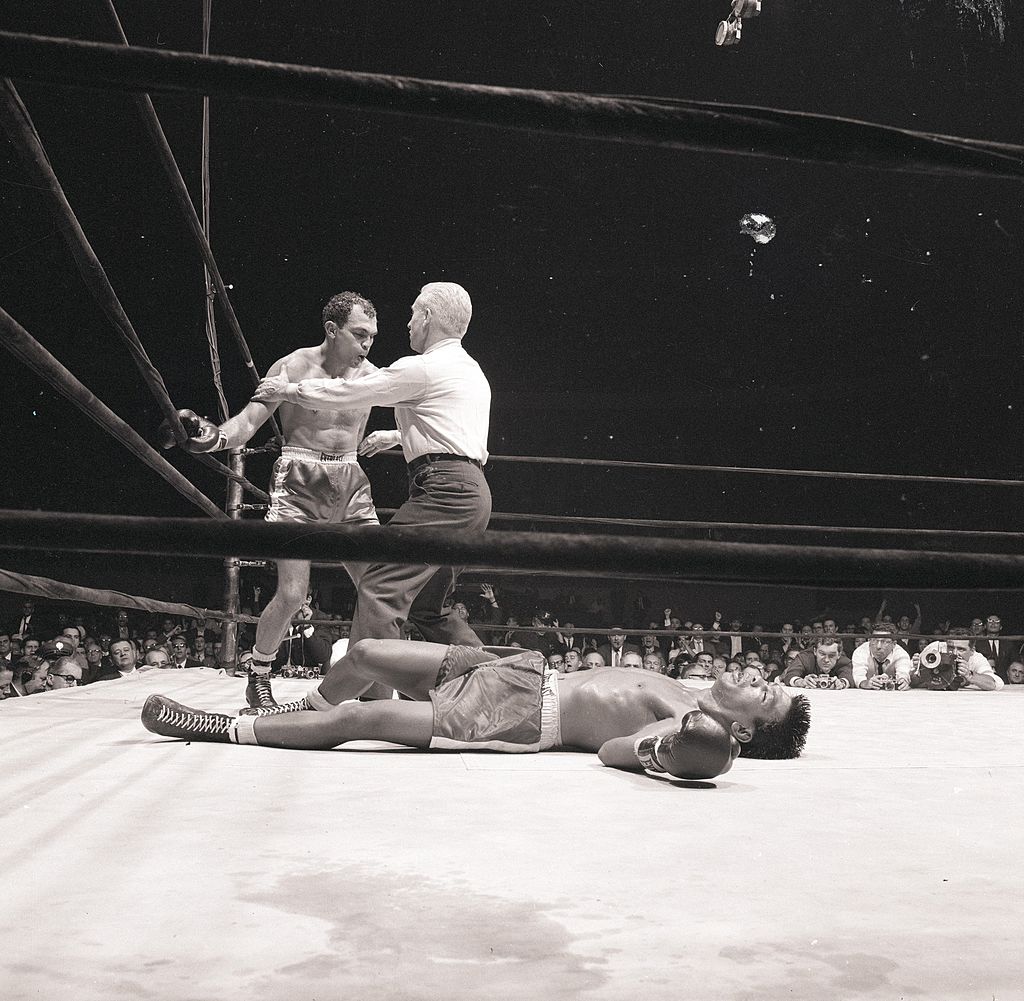
Carlos Ortiz floors fellow great Flash Elorde in January 1966. (Photo by Herb Scharfman/ Sports Imagery/ Getty Images)
Unlike Jofre, whose status as Brazil’s national boxing hero is perhaps unreplaceable, 1991 IBHOF inductee Carlos Ortiz, who was 85 when he passed away on June 13, sometimes undeservedly gets lost in the shuffle. According to BoxRec.com, there are over 30 past or present fighters named Carlos Ortiz, several of which are from the former junior welterweight and lightweight champion’s birth site of Puerto Rico or New York City, where he relocated with his family in 1947, when the best of the battling Carlos Ortizes began making his pugilistic mark out of necessity.
Although Ortiz – who, over the course of his 15-year pro career compiled a 61-7-1 record with 30 wins inside the distance – is one of first world-class Puerto Rican-born champions, his place in the island’s history and beyond perhaps has been overlooked to some extent because of the later emergence of such banner-carriers as Felix Trinidad, Miguel Cotto, Wilfredo Gomez, Hector Camacho, Jose Torres, Edwin Rosario and Wilfred Benitez.
“I consider Carlos Ortiz to be one of the greatest lightweight champions of all time and one of the greatest boxers, pound for pound, of all time,” said Ring Editor-In-Chief Doug Fischer in coming to the defense of a true champion whose legitimacy as such should be beyond dispute. “Whenever I come across a ranking of the best lightweights of all time or the greatest Puerto Rican fighters ever – either from a fan or a member of the media – that does not include Carlos Ortiz, I know the individuals who compiled those lists aren’t as knowledgeable about boxing history as they think they are.”
Depending upon which figure one chooses to believe, Smoger was either 72 or 79 (evidence tends to support the latter figure) when he passed away on December 19 after a long illness. Like Lane, Smoger had a distinctive style and he liked to point out he was the most-traveled of all referees, with assignments on five continents and in most U.S. states.
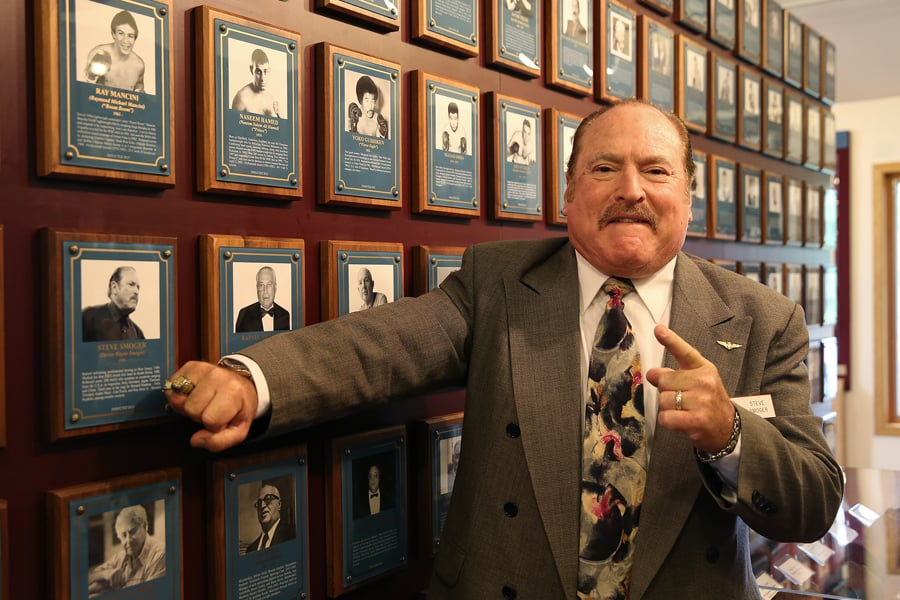
Steve Smoger beside his plaque at the International Boxing Hall of Fame.
“I like to work wherever and whenever,” the mustachioed Smoger said of his penchant for keeping busy and keeping his passport well-stamped.
Roth, 81, was inducted into the IBHOF in 2017. Born in Scranton, Pennsylvania, he began working as a judge for the Nevada State Athletic Commission, and for the next three-and-a-half decades until his retirement in 2015, he was at ringside for 225 world title bouts, including, among others, such marquee bouts as Holmes-Cooney, Chavez-Taylor I, Jones-Toney, Mayweather-De La Hoya, Holyfield-Tyson III and all three entries in the Bowe-Holyfield trilogy.
“It’s time,” said Roth upon his retirement in 2015. “It’s been a long run. I figured that I’ve had enough. “I was fortunate to have worked so many great fights.”
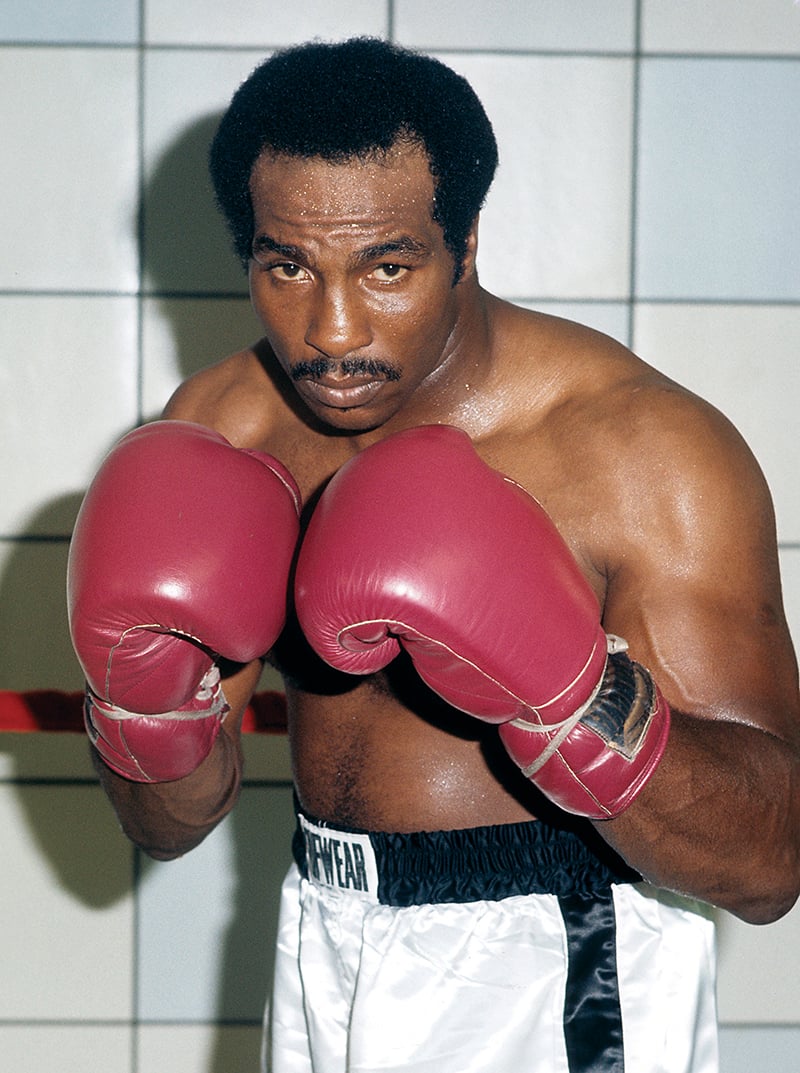
Earnie Shavers
Legendary heavyweight knockout artist Earnie Shavers, 78 when he took his eternal 10-count on September 1 following a brief illness, is not enshrined in the IBHOF, and may never be. Although Shavers (76-14-1, 70 KOs) twice fought for the heavyweight crown, losing by 15-round UD to Muhammad Ali on September 29, 1977, and by 11th-round TKO to Larry Holmes on September 28, 1979, he was such a devastating puncher that he instilled fear in everyone who shared the ring with him, even those who defeated him.
“Man, I been in there with the best,” said James “Quick” Tillis, who scored a 10-round UD over Shavers on June 10, 1982. “I fought a bald-headed guy named Earnie Shavers, who was the baddest dude in the world. He hit so hard, he could turn goat milk into gasoline.”
Holmes, who was perhaps more shocked than anyone after being knocked down in the seventh round of his title defense against Shavers, added his voice to the chorus of those who suggest that Shavers just might be the biggest banger in heavyweight history. “I hear people say, ‘Aw, man, he couldn’t possibly have hit as hard as everyone says.’ They think the stories about Earnie’s power are exaggerated. It’s no exaggeration. That power was real.”
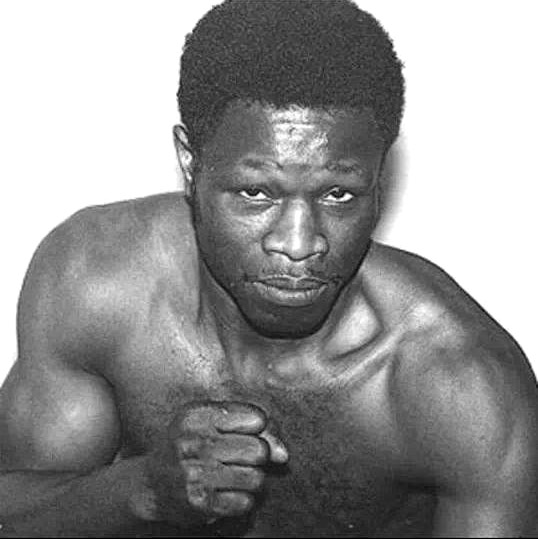
Buster Drayton
World champions who have not – at least to this point – passed muster with the IBHOF include IBF junior middleweight champion Buster Drayton (40-15-1, 28 KOs), former WBO 105-pound titlist Moises Fuentes (25-7-1, 14 KOs), onetime WBA and WBC flyweight champ Horacio Enrique Accavallo (75-2-6, 34 KOs), former Ring bantamweight champ Robert Cohen (36-4-3, 14 KOs), former WBA flyweight beltholder Berkrerk Chartvanchai (29-8-3, 6 KOs), former WBC bantamweight ruler Rodolfo Martinez (44-7-1, 35 KOs) and former Ring and WBC featherweight champ Johnny Famechon (56-5-6, 20 KOs).
Drayton, a chief sparring partner of the great Marvelous Marvin Hagler during Hagler’s frequent forays to Drayton’s adopted hometown of Philadelphia, was 70 at the time of his death on November 20. The personable and popular Drayton, a former Marine, became a world titlist when he wrested the IBF belt from Carlos Santos on a hard-fought majority decision.
Fuentes was just 37 when he passed away on November 24 after suffering a blood clot in his brain as the result of his final fight, against David Cuellar in 2021. Fuentes had previously reigned as the WBO 105-pound champ, defending the belt three times including a five-round stoppage of two-division champ Ivan Calderon, before challenging for world titles at junior flyweight on four occasions.
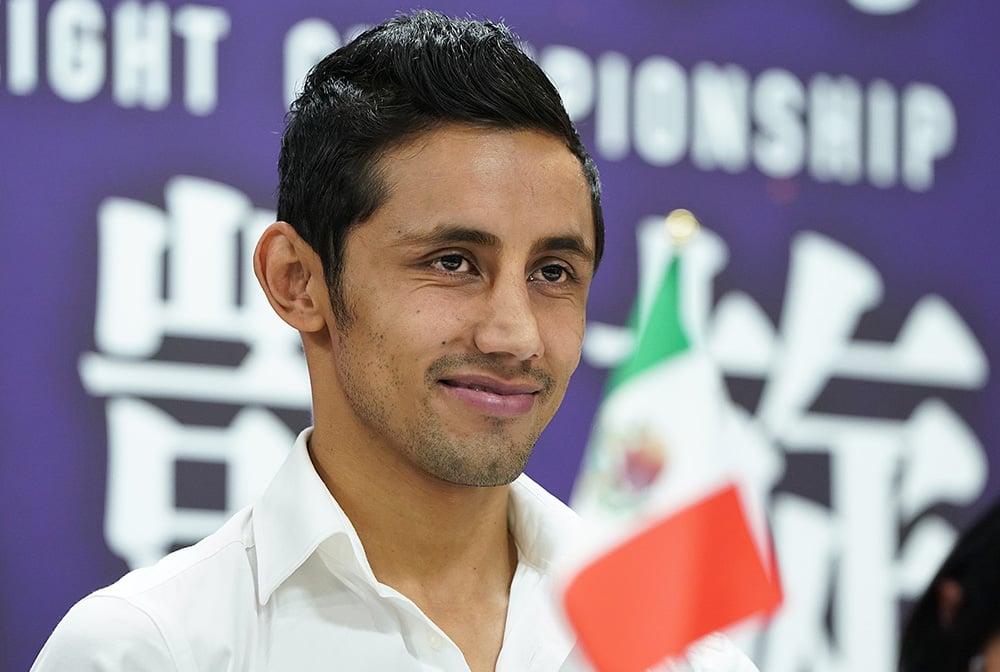
Moises Fuentes at the final press conference for his WBC flyweight title fight with Daigo Higa in February 2018. (Photo by Naoki Fukuda)
Accavallo was the unified WBA/WBC flyweight champion for a time, winning both titles on a controversial 15-round split decision over Japan’s Katsuyoshi Takayama on March 1, 1966, in Tokyo. The slick, 5-foot-1½ Argentine was 87 at the time of his death on September 14.
Cohen, a native Algerian who was a longtime resident of Paris, knew a thing or two about going the distance, holding onto life until he was finally obliged to let go at 91 on March 2 in Brussels, Belgium. He filled the vacant Ring bantamweight championship by scoring a split decision over Chamroen Songkitrat on September 19, 1954, in Bangkok, Thailand.
Bangkok was also the hometown of Berkrerk Chartvanchai and the site of his 15-round dethronement of WBA flyweight champion Bernabe Villacampo, of the Philippines, on April 5, 1970. But that career high point for Chartvanchai, who was 77 when he died on March 7, was followed by a downturn in which he lost eight of his last 11 ring appearances.
Martinez assumed the bantamweight throne with a fourth-round stoppage of his Mexico City rival Rafael Herrera, the WBC titleholder and two-time conqueror of legendary Ruben Olivares, in 1974. Martinez, who passed away a few days after his 74th birthday on August 14, defended the coveted green belt three times – in Colombia, Japan and Thailand – before losing it to future Hall of Famer Carlos Zarate.

Johnny Famechon
Famechon, another globetrotting champion, won the WBC and Ring featherweight titles with a 15-round decision over Jose Legra in England. The Paris-born Australian, who was 77 when he died on August 4, defended the 126-pound crown twice against legendary two-division champ Fighting Harada – a controversial decision in Sydney, followed by 14th-round stoppage in Japan – before losing it to future Hall of Famer Vincent Saldivar.
Among the notables who got their dream shot at the brass ring but came up short are Ron Stander, the “Council Bluffs Butcher,” 77 when he was outpointed by Father Time on March 8, and Colombia’s Mario Rossito, who said goodbye at 86 on August 22. Stander was served up as a human sacrifice to heavyweight champion Joe Frazier, who so tenderized his boy that Stander’s corner sued for peace after the fourth round. Not surprising; Stander’s then-wife Darlene gave her hubby so little chance that before the fight she said, “You don’t take a Volkswagen into the Indy 500 unless you know a hell of a shortcut,” which, alas, the Butcher didn’t have. Rossito attempted to unseat Ring/WBA/WBC junior welterweight champ Carlos Hernandez on May 15, 1965, but was stopped in four rounds.
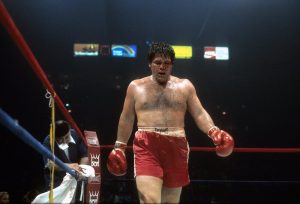
Ron Stander in the ring during his 1976 bout with Ken Norton. (Photo: The Ring Magazine/Getty Images)
Although no title was at stake when Germany’s Juergen Blin took on Muhammad Ali the day after Christmas in 1971 in Zurich, Switzerland, it might have seemed that way to Blin, who was knocked out in seven rounds but celebrated his up-close-and-personal experience with “The Greatest” for the rest of his life, which ended when he was 79 because of kidney failure on May 7 at a hospital in Hamburg.
Some deceased fighters who never rose above the “journeyman” level nonetheless deserve a mention, and one is Everett “Bigfoot” Martin, dead at 58, who, despite a deceiving 20-39-1 career record, was no day at the beach in giving such top-shelf fighters as George Foreman, Larry Holmes, Wladimir Klitschko (twice), Michael Moorer, Riddick Bowe, Dwight Muhammad Qawi and Tony Tucker all they could handle before finally succumbing.
New Orleans’ boxing community received a triple gut-punch in 2022 with the passing of three beloved homeboys: promoter/manager/trainer Les Bonano, 79, on May 22, and former welterweight contenders Percy Pugh, 81, on January 26, and Jerry Pellegrini, 78, on July 12.
Others who made their mark in boxing one way or the other were media members Michael Marley, 71, best known for his roles as boxing writer for the New York Post and later as the PR director for megapromoter Don King, and writer/professional powerlifter Ted Sares, 85, who succumbed to pancreatic cancer on August 31.
Bernard Fernandez is on Twitter:


